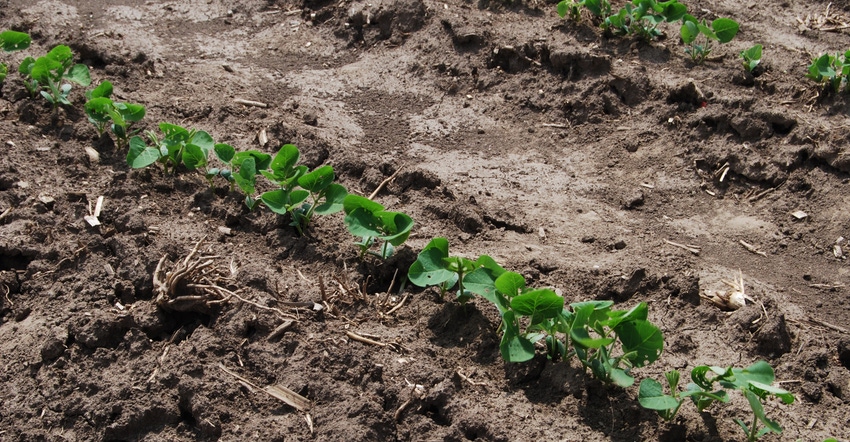May 23, 2018

It’s been another challenging season so far. A combination of cold temperatures creating challenges for seedlings, untimely rains impeding planting progress, and windy days wrecking spray schedules hit the highlights, or maybe lowlights, of the start of the 2018 growing season.
With soils cool and wet at soybean planting time, we are set up for more potential challenges that call for early-season scouting, with diseases toward the top of the list. For plant diseases to become a significant problem, typically three things must be in place: a host (soybean plants), pathogens (more on those below), and an environment that the pathogen can thrive in (cool plus wet equals likely early-season soybean disease pressure). Some pathogens do well in warm plus wet, so we aren’t out of the woods in that case either. Plant pathologists call this the “disease triangle.”
Dealing with disease triangle
We can’t do much about the presence of pathogens; they are plentiful in many fields. We don’t have control over the weather, and we have marginal control over the environment. We can improve drainage in areas, or work on soil structure and crop residue management, but in springs like this one, we will still have a favorable environment for early-season disease in many areas.
The other side of the disease triangle (host) is our opportunity to knock down disease levels by picking the right genetics and using seed treatments where needed.
Helping in the fight against early-season diseases, seed companies continue to bring us improved disease resistance genetics in soybean varieties. Since this built-in resistance is only effective against some of the usual seedling diseases and isn’t always able to hold up in the face of high pathogen pressure and environments favorable for diseases, we often add seed treatments as another disease management tool. Even with all these tools to fight soybean diseases, we’ll still need to scout; we’ll want to confirm our tools worked or not.
While there’s not much we can do about soybean seedling diseases after the seed is in the ground (short of a replant situation), scouting for and documenting any soybean seedling diseases is important. It can help us with diagnosing and interpreting what happens in our fields the rest of the season, and it might give insight into yield variability at season’s end.
The biggest reason for scouting and assessing any early-season disease is we can use this information to guide our disease management in the future. Anything we can do to help improve variety selection and seed treatment decisions to maximize returns is worth the scouting effort.
What are we looking for?
Several fungi can cause seedling diseases either before or after emergence. When seed fails to emerge because of fungal infection, we typically call it seed rot or preemergence damping-off. Pythium and phytophthora are the two primary fungal pathogens responsible for this in Iowa.
When plants are killed at seedling stage (after emergence), it’s often called seedling rot or blight, or postemergence damping-off. Pythium and phytophthora are on this list, along with rhizoctonia and fusarium.
For areas lucky to have any early-planted soybeans, pythium is often the fungus responsible for damping off because most species of (research identified at least 50 that can attack soybean) prefer cold soil temperatures (from 50 to 60 degrees F). It tends to be worse in soils with drainage issues and high residue.
Pythium can cause seed rot or infect seedlings after emergence, often called seedling blight or damping-off. The infected plants have a water-soaked appearance and are easily pulled from the soil because the roots are rotted. “Pinched-off” hypocotyls are often associated with pythium.
If your soils were warmer (near 70 degrees or above), the phytophthora fungus becomes a more likely culprit. Because it likes warm, wet soil, it is more likely to occur in soybeans planted later in May or into June. Phytophthora is most common in areas with poor drainage but can occur in well-drained fields that are saturated for seven to 14 days due to excessive rains, like we’ve had this season in many areas.
While some symptoms are hard to differentiate from pythium on rotten seeds or very small seedlings, phytophthora offers some clues on larger seedlings. As seedlings approach V2 growth stage, often you can find dark-brown lesions beginning on the lower stems and progressing upward. If you cut into infected seedlings, you typically find similar discoloration deep into the stem tissue. Diseased seedlings look wilted with grayish leaves that turn yellow but remain attached to the plant.
Rhizoctonia fungi are also active when soils are warm. But since this fungus grows better in aerated soils, we see it more on slopes than in heavy bottomground soils. Unlike phytophthora damping-off, stem discoloration by rhizoctonia is usually localized brown to reddish-brown lesions at the soil line or below, which are limited to the cortical, or outer layer of the stem, while the rest of the infected stem remains firm and dry.
While it can cause stand loss, more often I see rhizoctonia fields having an uneven look to them, with infected seedlings being stunted and having a more pale-green color than healthy plants. Sometimes plants “outgrow” early-season rhizoctonia infections, but it can also continue to attack plants and cause root rot well into midseason.
Put your information to work
Identification of early-season diseases can be tricky, but it is useful information to have to plan your disease management strategy in future years. Once we have dialed in on the primary pathogens in clients’ fields and planned for the pathogens with resistant genetics or the right seed treatments, we’ve seen the early-season disease issues substantially decrease.
After scouting and comparing what you are seeing in the field to the descriptions of key diseases, if you still need help identifying what is ailing your soybeans, don’t hesitate to consult with your seed agronomist or local Extension field agronomist. Another good option is to send a sample in to the ISU Plant and Insect Diagnostic Clinic.
Knowing what pathogens you’re dealing with is the biggest piece of the puzzle, letting you fine-tune genetics and seed treatments to reduce your risk of early-season soybean diseases going forward.
Of course, while you are out there scouting for diseases, you can also check for insect issues, take stand counts and watch for weed escapes, to name a few other reasons to scout. I’ll throw a plug in for the many crop scouting apps and field guides available.
My favorite is the ISU Corn and Soybean Field Guide. We recently updated it, and in addition to disease identification, it covers most other pests and disorders of corn and soybeans in the Midwest.
McGrath is the on-farm research and Extension coordinator for the Iowa Soybean Research Center at ISU. Contact him at [email protected].
About the Author(s)
You May Also Like






